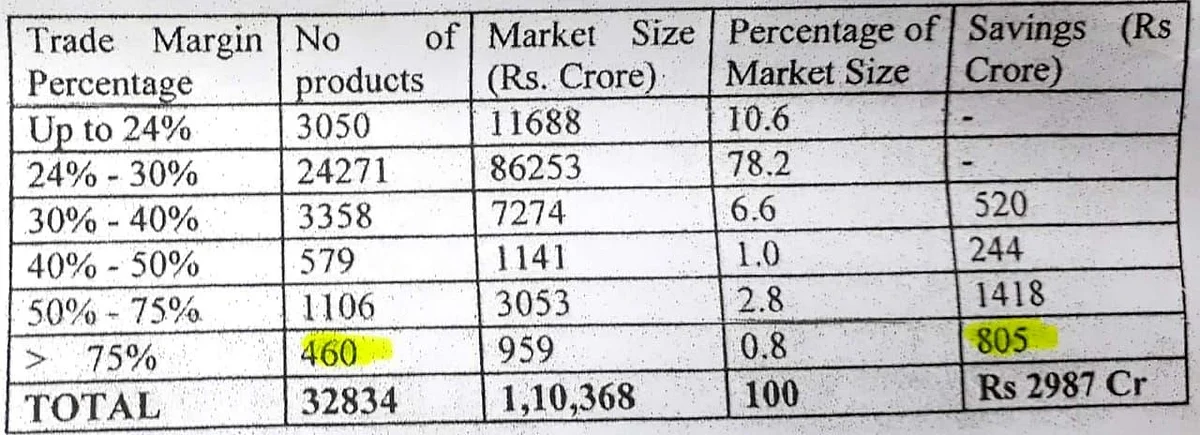Overpriced medicines bled exchequer of Rs 2,987 crore, admits Modi govt; whistleblower claims “scam” bigger
The Modi government has provided incorrect data as to the number of medicines flouting price control rules and making a profit of more than 75 per cent

The Narendra Modi government has admitted to financial irregularities to the tune of Rs 3,000 by medicine-sellers, as per the latest data available with the Ministry of Chemicals and Fertilisers’ Department of Pharmaceuticals.
The overpriced costs, which the government says amounted to Rs 2,987 crore at the end of March 2017, are being borne by medicine buyers.
“As per the Pharmatrac Data for March 2017, it is observed that approximately 89 per cent of the market of non-scheduled medicines with 27,321 products is having a trade margin of less than 30 per cent,” the Ministry of Chemicals and Fertilisers wrote on Jan 24 to PR Somani, a Telangana-based engineer and the Founder President of The Nizamabad Chamber of Commerce and Industry.
“This means, more than 30 per cent trade margin is enjoyed by only 11 per cent of the market of non-scheduled medicines,” the ministry said in its written reply.
“The manufacturers of Non-scheduled formulations are not permitted to increase the price by more than 10 per cent per annum,” the government’s reply said, indicating that the price control rules were being openly flouted in the sale of various drugs.

Somani, however, says that the Rs 2,947-crore loss to the Indians, cited by the government, is the just the tip of the iceberg, and the actual “medical scam” is much bigger in terms of financial loss inflicted upon the Indian taxpayer.
As per data on the MRP of medicines, available with Somani and reviewed by National Herald, products from at least six pharmaceutical companies – Abbott (223 products), Cipla (179), Theogen (273), Emcure (99) and Wockhardt (76) – are being sold to customers with a profit margin more than 75 per cent, with several products going with a profit cap as high as 2,125 per cent.
In all, at least 850 medical products from just six companies are going for a profit margin greater than 75 per cent, much higher than 460 products cited by the Ministry of Chemicals and Fertilisers in its reply. A majority out of those 850 medicines were reaching consumers at a trading margin greater than 1,000 per cent, as per records.
“The magnitude of this scam is much bigger. They have just admitted to pricing discrepancies (margin greater than 75 pc) in 460 products. I submitted them a comprehensive list of 32,000 products. I could identify close to a 1000 products going for grossly high prices, that were manufactured by just six companies,” notes Somani, who believes that the government is holding back the actual data from the public.
“There is a huge difference between wholesale price and retail price of medicines. For instance, pharmaceutical companies are printing abnormally high MPRs, even up to 3,000 per cent, more on their selling price of medicines, including generic medicines, life-saving drugs and even surgical equipment,” complains Somani.
The government’s list, as highlighted above, only mentions a mere 460 products which are being sold in the market with a profit margin greater than “75 per cent.”
“The prices of lion’s share of medicines in the market remain unregulated. “The government has not executed recommendations of its own committee, headed by a Joint Secretary, that had recommended the margin at 35 per cent,” notes Somani.
Explaining the difference between different varieties of drugs, former Indian Medical Association (IMA) President Dr KK Aggarwal says, “If you add any salt to a patented or a scheduled drug, it becomes a non-scheduled drug. This way, they can manipulate the government rules.”
“Scheduled drugs are patented/branded drugs and comprise just 20 per cent of the market, in contrast to unscheduled drugs, which include many generic medicines and together make up 80 per cent of the drugs available in the Indian market,” explains Aggarwal, a former Padma Shri awardee.
The Drug (Prices Control) Order, 2013 (DPCO, 2013), stipulates the fixing of “ceiling prices” of various scheduled formations by allowing a 16 per cent margin to the retailer and 8 per cent margin to whole sellers.
As of 2016, 680 medicines were under the National List of Essential Medicines (NLEM), out of which there had been a fixed profit ceiling for 530 medicines.
Aggarwal says it is rather easy for private pharmaceutical companies to get their names off the NLEM list, so as to “ward off” the government’s price control rules.
Follow us on: Facebook, Twitter, Google News, Instagram
Join our official telegram channel (@nationalherald) and stay updated with the latest headlines
- Narendra Modi
- Indian Medical Association
- medical scam
- Dr KK Aggarwal
- Ministry of Chemicals and Fertilisers